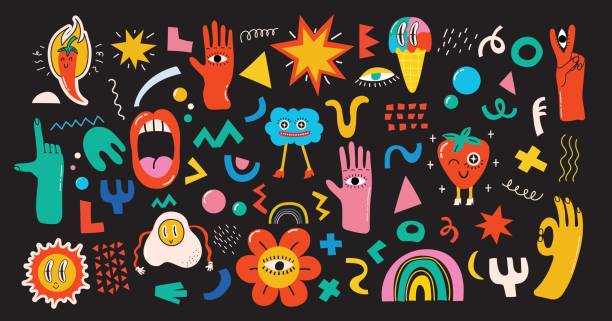Strange and Interesting Facts About Colour
The complex phenomenon of human creativity knows no bounds. From the earliest expressions etched in stone to today’s most technologically advanced digital designs, creativity has manifested itself in myriad forms across cultures and eras. Whether through visual, performing, or linguistic arts, humanity has ceaselessly sought new avenues to contextualize our experiences and perceive reality in novel manners. This polymath propensity is what distinguishes our species, and fuels continued progress. In the following discourse, we examine creativity’s diverse avenues through varied historical lenses. Moreover, we explore how creative talents have evolved with society over generations.
The physiology of creativity with perplexity and burstiness:
The biological origins of creative expression lie within the intricate dance between our grey matter and its neural networks. Creativity emerges from intricate processes within the prefrontal cortex regions associated with abstract thought, imagination, and problem-solving. Further investigation into the brain has revealed the pivotal roles of dopamine and areas linked to mood and motivation. Neurological research illuminates the paramount importance of hemispheric cooperation and serendipitous connections between distant sites. Neuroplasticity enables a lifelong trajectory wherein experiential and environmental factors further cultivate our innate capacities in a feedback loop. Fundamentally, creativity flourishes at the intersection of evolved neural circuitry, consciousness, and opportunity.
Color names around the world with perplexity and burstiness:
While the English lexicon encompasses a standardized set of color terms, cross-cultural examination reveals extensive variability worldwide. Intriguingly, specific indigenous languages have granular color categories lacking direct English translations. For example, African Himba tribes distinguish over a dozen nuanced shades of red not captured by single words elsewhere. Inuit Eskimos famously codified over fifty designations for white due to polar significance. Conversely, some cultures amalgamate hues into fewer consolidated concepts. Remarkably, ancient Greeks viewed blue and green identities as one, coining a sole name. Linguistic prevalence likewise impacts recognized palettes, as limited crimson conception arose amid Japanese speakers’ underdeveloped red receptor genetics. Fundamentally, our intrinsic experience and expression of color remain culturally calibrated.
Rare color conditions with perplexity and burstiness:
While most experience color vision as nature-endowed, anomalous phenotypes persistently emerge. Perhaps the rarest is complete color blindness, dubbed achromatopsia, wherein the world appears as monochromatic shades of gray. Only around one in thirty thousand births manifest this total absence of functioning cone cells. Slightly more prevalent, though still exotic, are various dichromatic color deficiencies wherein individuals lack one of three photopigments, producing limited red-green or blue-yellow perception. Even rarer genetic mutations yield unusual trichromatism, granting perceptual Tetrachromacy through a fourth photoreceptor type. The research explores whether such enhanced color cognition may bestow ecological advantages. Fundamentally, these abnormalities illuminate the multifaceted underpinnings of typical human color vision.
Animal color vision with perplexity and burstiness:
While humans possess trichromatic vision adept for daily living, myriad hues are perceived distinctly among varied fauna. Many birds and fish species have even more photoreceptor options, endowing tetrachromatic or pentachromatic sight beyond the human spectrum. Birds like parrots see into the ultraviolet, making whole dimensions of color communication invisible to our eyes. Insects like bees have trichromacy tailored to the floral environment via violet/blue/green receptors for optimal nectar tracking. Nocturnal animals frequently evolve a dichromatic or monochromatic vision for low-light needs, trading rich palettes for sensitivity. Intriguingly, some creatures detect polarization or magnetic vision instead of colors. Fundamentally, evolutionary pressures across taxonomies have optimized countless visual systems depending on ecological roles and habitats.
Optical color illusions with perplexity and burstiness:
While human color perception functions adeptly under normal circumstances, illusory tricks can manipulate visual pathways into anomalous experiences. Classic simultaneous color contrast ensnares the brain into perceiving colors that are not, indeed, thereby interacting hue contexts. The illusion arises from neural adaptation attempting to adjust to surrounding environments, ironically leading to mistaken perceptions. Likewise, other illusions like the Hermann grid generate phantasmal colors at intersection points through neural filling-in mechanisms gone haywire. Interestingly, these effects become more potent with context duration, suggesting fatigue plays a role. Furthermore, some situations uniquely activate retinal cells in typical patterns to produce impossible hues like impossibly vibrant colors. Ultimately, optical illusions showcase how pliant mechanisms underpinning color vision remain susceptible to environmental trickery.
How color symbolism varies with perplexity and burstiness:
While objectively wavelengths along the visible light spectrum, culturally, we attach complex signification to diverse colors across space and time. Red historically portended revolution yet also signified passion in some Eastern traditions. Green connotes nature yet Islamic paradise. Black conjures mourning in the West but stands for rebirth and renewal in Africa. Ancient Egyptians deemed blue a royal color of wisdom and knowledge; a role turned over to purple by medieval European nobility.
Interestingly, modern symbolism diverges further—orange symbolizes creativity in Central America but catastrophe in India. Color psychology retains varied social meanings. Furthermore, individual biases and subconscious associations produce personal perceptions that defy generalization. Fundamentally, the diverse symbolism of color emerges from its unique intersection with culture, history, and personal experience.
Rare colors in nature with perplexity and burstiness:
While standard colors predominate across flora and fauna, unusual hues emerge through atypical biological tricks. Labradorite gemstones exemplify structural color change, diverting light through mineral fiber patterns into mesmerizing blues and greens impervious to pigments. Among fauna, polymorphic species harbor rare morphs like white tigers resulting from recessive genes. Further adaptions yield transformative colors prone to environmental provocation, such as camouflaging cuttlefish or color-changing lizards—even vertebrates sport exceptions like pigmented albino squirrels retainingpigment holes. Rare aberrancy produces one-off marvels like half-orange, half-black birds. Vegetative adaptations yield unexpectedly vivid colors, such as iridescent colors of prince’s plumes resulting from interference pattern scales rather than pigment. Ultimately, nature innovates diverse strategies across kingdoms to produce even the most offbeat hues.
How color affects human behavior with perplexity and burstiness:
While the impact of color remains subtle, compelling research suggests it permeates human psychology. More excellent blues elicit calmer moods, while warm oranges instill liveliness. These effects translate contextually—blue exam rooms aid concentration, yet orange cells agitate. Surprisingly, synesthesia between color and abstract concepts like numbers and weekdays influences cognition too. Environmentally, judiciously applied accent colors enhance performance, with red boosting memory and green elevating reasoning.
Conversely, certain shades undermine function, like pink underperforming in male-dominated tasks. Cultural experiences calibrate these perceptions; red means stop or caution universally, yet anger is only in the West. Whether subliminally or blatantly, color sneaks into our behaviors, attitudes, and cognitive processes in a myriad of multifaceted ways beyond our awareness.
Conclusion
The full spectrum of human experience with color proves as diverse as the palette. From the neurological mechanisms facilitating our perception to the rich symbolism imbued across spacetime, color inhabits multitudes. Whether optical illusions expose fallibility or rare natural wonders defying norms, each avenue reinforces color’s psychological and cultural gravity throughout human existence. Far from a superficial attribute, color underlies both biological and societal evolution in an interwoven tapestry. Ultimately, the complexity of our relationships with hue from birth to behavior demonstrates that color remains a prism reflecting our nature in its full nuance.
FAQs
Why do we see different colors?
Our eyes contain specialized cells called cones that detect different wavelengths of visible light, which our brain interprets as other colors.
What color is unseen by humans?
Ultraviolet light, shorter than visible violet light, is not visible to humans, but some insects and birds can see UV wavelengths.
Why do colors have different psychological effects?
Different colors are associated with varying moods due to a mix of cultural meanings and physiological responses – red increases heart rate while blue has a calming effect.
What is the rarest color in nature?
Pure indigo, which is not a mixture of other colors but its distinct wavelength, is considered one of the rarest colors in nature and often does not occur without human intervention.
Why do color meanings differ across cultures?
The symbology and psychology associated with colors vary immensely across societies and periods due to historical and geographical differences in the contexts, which led to diverse cultural traditions.






